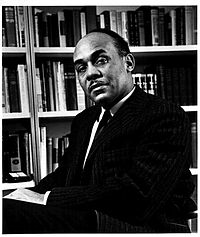Dead Man
From Wikipedia, the free encyclopedia
-
Dead Man is a 1995 film written and directed by Jim Jarmusch. It stars Johnny Depp, Gary Farmer, Billy Bob Thornton, Iggy Pop, Michael Wincott, Lance Henriksen, and Robert Mitchum (in his final role). The movie is something of a Modern Western, with many twisted elements of the Western. The film is black-and-white.
Plot
The era is never explicitly stated, but Jarmusch has reported that Deadman is set in the 1870s.
Johnny Depp stars as an accountant named William Blake. His parents have both recently died, and his fiancee broke off their engagement. Blake uses his last remaining money for a train ride from Cleveland, Ohio to a town out West known as Machine, for a job offered him in a letter. After arriving at the Dickinson Metal Works, he finds the letter was sent months ago; his job position has already been filled. Blake demands to see Dickinson, played by Robert Mitchum, who then points a shotgun at Blake and tells him to get out or get shot. "The only job you're gonna get is pushin' up daisies from a pine box."
William Blake comes across Thel (Mili Avital) formerly a prostitute, (according to an off-hand comment by a man who shoves her into a muddy street), who is selling paper flowers. In the next scene, Blake and Thel are lying on her bed when Dickinson's son, Charles, who happens to be the woman's ex-fiancé, opens the door and finds the two. After a short speech, he takes out a gun and aims for Blake - but he kills Thel instead when she shields Blake with her own body. Blake takes the gun Thel had shown him earlier and shoots down Charles. Blake is next seen with a wound in his chest, trying to get out through the window. He escapes with Charles's horse.
Mr. Dickinson hires three killers to track down and bring Blake back, dead or alive, for stealing his prized horse, for the murder of his son and the supposed murderer of Thel (Mr. Dickinson seems more concerned with recovering the valuable horse than with avenging his son's death).
The next morning, after running away with that horse, Nobody (a Native American), played by Gary Farmer finds him, mistakes Blake for his namesake, attempts to heal his wound, then realizes it will eventually be fatal. Nobody keeps wandering the land, while Blake, due to his apparent weakness, is forced to follow him, and along the way, help kill many of the violent, deranged people they keep encountering.
Nobody and Blake are temporarily separated, a time during which Blake encounters two marshals who are after the bounty placed on his head by Dickinson. Blake kills these men by shooting them after asking them if they'd "heard of his poetry" (his gun symbolizing his words, as it were.) Blake then wonders through the wilderness, coming across a dead fawn and two dead white men with arrows in their chest, among other things. Eventually Blake stumbles upon Nobody, who is having sex in the woods, and the two are re-united. Meanwhile, out of the three hired killers, only one has survived, this one having shot the other two and eaten the second.
Blake and Nobody continue on their journey together and also continue to be shot at by random people. Amazingly enough, none of these shots seem to be able to hit Blake. Blake and Nobody travel from the Crow area of the Southwest, up to (presumably) the Makahs along the Northwest Pacific coast. Towards the end, however, Blake takes a bullet to his left arm and is brought to a Native American village by Nobody.
Blake, now barely alive, is put into a canoe and sent to the sea to in order to return to the realm of souls. The remaining hired killer comes upon the shore just as the canoe is setting out, and Nobody and the killer shoot each other dead. Blake observes the skyline and eventually closes his eyes while his canoe heads off into the far-off ocean.
The two Blakes
There are numerous references to William Blake (18th-19th century artist and writer of the same name) scattered throughout the film.
- Blake (portrayed by Depp) is not initially familiar with the works of poet. One of the more memorable lines in the film comes from Depp's character before he kills a man; after the victim asks if he's William Blake, Blake replies, "Yes I am. Do you know my poetry?" and then shoots. The poetry of William Blake is quoted several times in the film by Gary Farmer's character, a Native American named Xebeche, but who prefers to be called Nobody.
- Nobody was acquainted with the works of Blake when he was captured by English soldiers and sold as a circus curiosity to be exploited throughout North America and England before being assimilated. He then finally escapes to his people, only to be rejected as a liar when he tells of his experiences. Nobody's character is fictional but there are many well-documented instances of Natives exploited like this throughout the early history of the New World.
- Another character, a parricidal cannibalistic bounty hunter indirectly refers to Blake's poetry when he advises a colleague not to drink water from a still pond ("Expect poison from standing water" -Blake).
- The character Thel is presumably a reference to Blake's Book of Thel.
Spoilers end here.
Deadman and Native American cultures
This film is generally regarded as being extremely well-researched in regard to Native American culture. [1]
Dead Man is also notable as one of rather few films about Native Americans, as directed by a Non-Native, that offers nuanced and considerate details of the individual differences between Native American tribes, and furthermore free of common stereotypes. There are untranslated passages in several Native American Languages, and Jarmusch included several in-jokes aimed at Native American viewers.
The movie makes many poetic statements about both Native American and Anglo-American cultures.
Response
In its theatrical release, Dead Man earned about $1 million for a budget of $9 million.[2] It is the most expensive of Jarmusch's films, due to the expense of black-and-white film processing, and the costs of ensuring accurate period detail.
Critical responses were mixed. Roger Ebert gave the film one-and-a-half stars (out of four stars maximum), noting "Jim Jarmusch is trying to get at something here, and I don't have a clue what it is."[3]. Desson Howe and Rita Kempley, both writing for the Washington Post, offered largely negative appraisals.[4] Greil Marcus, however, mounted a spirited defence of the film, titling his review "Dead Again: Here are 10 reasons why 'Dead Man' is the best movie of the end of the 20th century."[5]
A book on the film was written by film critic Jonathan Rosenbaum (ISBN 0-85170-806-4).









